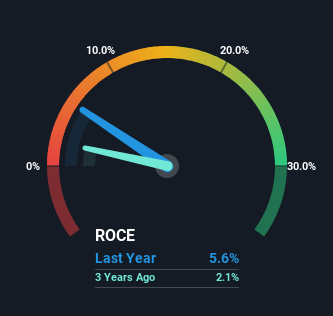- Belgium
- /
- Construction
- /
- ENXTBR:ACKB
Ackermans & Van Haaren (EBR:ACKB) Has More To Do To Multiply In Value Going Forward

Finding a business that has the potential to grow substantially is not easy, but it is possible if we look at a few key financial metrics. Firstly, we'll want to see a proven return on capital employed (ROCE) that is increasing, and secondly, an expanding base of capital employed. Ultimately, this demonstrates that it's a business that is reinvesting profits at increasing rates of return. In light of that, when we looked at Ackermans & Van Haaren (EBR:ACKB) and its ROCE trend, we weren't exactly thrilled.
Understanding Return On Capital Employed (ROCE)
If you haven't worked with ROCE before, it measures the 'return' (pre-tax profit) a company generates from capital employed in its business. Analysts use this formula to calculate it for Ackermans & Van Haaren:
Return on Capital Employed = Earnings Before Interest and Tax (EBIT) ÷ (Total Assets - Current Liabilities)
0.056 = €514m ÷ (€19b - €9.8b) (Based on the trailing twelve months to December 2023).
So, Ackermans & Van Haaren has an ROCE of 5.6%. Ultimately, that's a low return and it under-performs the Construction industry average of 11%.
Check out our latest analysis for Ackermans & Van Haaren

In the above chart we have measured Ackermans & Van Haaren's prior ROCE against its prior performance, but the future is arguably more important. If you'd like, you can check out the forecasts from the analysts covering Ackermans & Van Haaren for free.
What The Trend Of ROCE Can Tell Us
The returns on capital haven't changed much for Ackermans & Van Haaren in recent years. Over the past five years, ROCE has remained relatively flat at around 5.6% and the business has deployed 35% more capital into its operations. Given the company has increased the amount of capital employed, it appears the investments that have been made simply don't provide a high return on capital.
On a separate but related note, it's important to know that Ackermans & Van Haaren has a current liabilities to total assets ratio of 52%, which we'd consider pretty high. This can bring about some risks because the company is basically operating with a rather large reliance on its suppliers or other sorts of short-term creditors. Ideally we'd like to see this reduce as that would mean fewer obligations bearing risks.
Our Take On Ackermans & Van Haaren's ROCE
In summary, Ackermans & Van Haaren has simply been reinvesting capital and generating the same low rate of return as before. Although the market must be expecting these trends to improve because the stock has gained 44% over the last five years. However, unless these underlying trends turn more positive, we wouldn't get our hopes up too high.
If you'd like to know about the risks facing Ackermans & Van Haaren, we've discovered 1 warning sign that you should be aware of.
For those who like to invest in solid companies, check out this free list of companies with solid balance sheets and high returns on equity.
New: Manage All Your Stock Portfolios in One Place
We've created the ultimate portfolio companion for stock investors, and it's free.
• Connect an unlimited number of Portfolios and see your total in one currency
• Be alerted to new Warning Signs or Risks via email or mobile
• Track the Fair Value of your stocks
Have feedback on this article? Concerned about the content? Get in touch with us directly. Alternatively, email editorial-team (at) simplywallst.com.
This article by Simply Wall St is general in nature. We provide commentary based on historical data and analyst forecasts only using an unbiased methodology and our articles are not intended to be financial advice. It does not constitute a recommendation to buy or sell any stock, and does not take account of your objectives, or your financial situation. We aim to bring you long-term focused analysis driven by fundamental data. Note that our analysis may not factor in the latest price-sensitive company announcements or qualitative material. Simply Wall St has no position in any stocks mentioned.
About ENXTBR:ACKB
Ackermans & Van Haaren
Engages in the marine engineering and contracting, private banking, real estate and senior care, energy and resources, and growth capital businesses worldwide.
Excellent balance sheet with proven track record and pays a dividend.
Market Insights
Community Narratives



